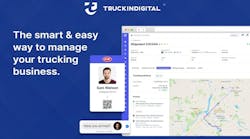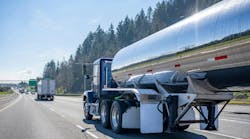WITH the rapidly increasing complexity of fleet management, trailer-tracking technology has become of paramount importance. It's the difference between efficiency and inefficiency.
Trailer tracking can be defined as an asset increases a fleet's efficiency and security by electronically monitoring key parameters. Examples of parameters are location (GPS), product temperature, in-transit heat temperature, suspension data (tire pressure, wheel-end temperature), and security seals/locks.
“It gives you eyes in the field you didn't have before,” said Dave Baker, Lat-Lon president. “In general all of us, have the ability to see things we didn't see before. We all have cell phones. There was a day when none of us had them. People always get this technology and go, ‘Wow, this is great.’ Pretty soon they realize they're working with information now that they never had before, and they'd never go back.”
At the National Tank Truck Carriers annual Cargo Tank Maintenance Seminar and Equipment Show October 26-28, 2009 in Nashville, Tennessee, four executives gave an update on advancements in tracking equipment technology.
Dave Baker, Lat-Lon
Lat-Lon, whose tank truck customers include Brenner Tank and Arizona Chemical, makes self-powered GPS monitoring devices that send live data via cellular to the Internet and are solar-powered, trailer-mounted, and not wired to trailer lights.
“There are two basic ways of getting data into the GPS unit: wireless sensor and wired sensor,” he said. “Wireless is like a garage-door opener. It sends a burst of data, and the main unit picks it up and incorporates it into the overall data packet. All data goes to the server Web site and is viewable upon login. Current units have radio frequency (RF) sensors that can be deployed — up to 10 of them for each STU. They can be placed in different locations or added later to the main system. Unlike the main STU, the sensors have their own battery power. One thing that's important in the rail market is impact protection: internal to the STU is a three-axis accelerometer.”
The STU camera sensor means that the unit can be paged and told, “Take a picture.” Pictures taken are based on the following: digital state change (door open) and paging the unit (user request). Pricing is on a per-picture basis. Pictures can be used to authorize responses and confirm primary alarm generation (eg, unauthorized person identified).
STU data includes temperature reports captured during a tank trailer trip: loaded (rapid rise), cool-off during transit, and empty and rapid fall.
Next Page: Edward Miller, SkyBitz Inc
NTTC Cargo Tank Maintenance Seminar...
Captured data is available through a Web site user interface. “It doesn't do anybody any good to have hundreds of messages if they don't have actual data,” Baker said. “How do I get to a short list of my data? How do I get to that action item list? We have specialty reports that give meaning to the data.”
Web site capabilities include: secure login for mobile and desktop versions; current fleet data or historical unit histories; specialty reports such as pooling (data within a pool on how many assets are in that pool), dwell (how long something has been in one place), start/stop (how much time in motion and stopped), geofence (how many trailers are in that area and how long they've been there).
Administrative functions for managing the fleet include: sub-user accounts for customers; custom report building; custom alerts (e-mail/text messaging, such as, “tank temperature below 125° C”); configuration changes uploaded to the deployed STUs; geofences and geopoints created and managed (mileposts on a highway, for example).
“If you're looking at maps all the time, you're wasting time,” he said. “You want data that says, ‘Hey, I'm at the distribution center in Kansas City.’ Or, ‘Hey, I'm at milepost 334 on I-70.’ You're dealing with reports. You can't go to the map for each particular unit.”
The functions also include a dispatch page showing live updates of the entire fleet via GIS/map display and displayed message content.
“One of our applications in the tank trailer marketplace was for Arizona Chemical to interface with existing sensors on their trailers,” he said. “It's a high-temperature product shipped north of 300° F, and they wanted to be able to track temperature as well as GPS location. They needed an alert if the product got too cold. If they were shipping long distances, they needed to divert and unload the tank before it got too cold and solidified. The customer already had sensors in the trailer, so we developed an interface to the sensors they had and wired up to them.”
Edward Miller, SkyBitz Inc
“These things are going to help you drive the efficiency of your organization,” he said.
Asset-tracking advantages are seen in:
-
Trailer utilization: accurate idle status, daily idle time report, turn-time by location, radius search, idle analysis, pool management, and fewer rentals.
-
Driver management: notifications and alerts, driver stops, load tracking.
-
Driver and equipment: trailer radius search, reduce out-of-route miles, reduced fuel cost, driver hours/time savings.
-
Security: trailer theft recovery, load theft recovery, lower insurance cost, trailer abuse control, temporary profile visibility, panic mode.
-
Supply-chain visibility: real-time departures, real-time arrivals, in-route updates and visibility, shipment estimated time of arrival.
-
Operation manhours: no more yard checks, satellite view to help drivers, dispatch system load status.
“At SkyBitz, we look at things in terms of a multimode world: over the road to rail to seaport and out,” he said. “It's total supply-chain visibility. It's in-transit visibility throughout: bringing raw materials to the manufacturing plant, turning those materials into a widget of some kind, then all the way to retail sector. Some products may go overseas; some may stay inside the country. If you don't have asset tracking, then maybe one of your partners does, and you'll want to integrate systems.”
He said asset tracking:
-
Optimizes efficiency of goods movement by analyzing data regarding the location, movement, and status — in real time.
-
Continuously optimizes the supply chain by monitoring performance and providing data for iterative process optimization.
-
Provides significant operational and customer facing benefits through increased efficiency, customer benefits, and security.
-
Increases utilization of equipment and goods, optimizes fleet dispatch, and improves routing efficiencies.
-
Advances coordination with multiple players in the supply chain through improved in-transit asset visibility and communication.
-
Offers security on-demand and real-time asset monitoring and control that aid in both proactive monitoring and reactive recovery.
“We try to focus on event-based notifications,” he said. “Is it important to know where your truck is every day at six in the morning? Maybe not, but you do want to know when it moves, so we incorporate motion sensors that tell when the vehicle starts and stops.”
Next Page: Kelly Overton, Qualcomm
NTTC Cargo Tank Maintenance Seminar...
Kelly Overton, Qualcomm
He said trailer-management systems offer: faster detection and recovery of stolen trailers and a reduction in associated insurance costs and other losses; an increased number of loads per month carried by each trailer; a reduction in the size of trailer fleets of up to 20%, according to some estimates; a reduction in the number of staffHe said best-in-class, untethered trailer-management data typically includes the following tasks to help optimize trailer pool size:
-
Determining if trailer pool commitments are being observed by customers.
-
Obtaining historical detention information for use in contract negotiations.
-
Identifying demand trends versus supply over time by location.
-
Improving utilization by redeploying trailers from low-utilization operations.
Carriers benefit in the following ways: eliminating unnecessary tasks of tracking trailers for customer service and load planning through integration of data; eliminating scrambling and backtracking to locate “missing” trailers; more accurate inventory management and dispatch operations; enabling quick responses to unexpected shipment opportunities that can win new customers; conducting utilization analyses, trend-spotting, and long-term management; and better customer service.
Untethered tracking systems can reduce theft-related expenses and differentiate carrier services by: alerting carriers promptly about unauthorized domelid and valve openings, trailer movements, and the unloading of trailers at unplanned locations; alerting carriers when trailers fail to report their locations according to schedule; enabling carriers to proactively manage missing trailers; enabling faster recovery of stolen trailers and cargo by supplying trailer location data; minimizing the ancillary costs of theft including insurance, cargo and trailer loss, employee time, and customer service failures; acting as a deterrent to prevent cargo theft.
Timely, more accurate information is available through: time- and date-stamped position reporting, connect and disconnect notification, drop and hook events, and dwell times; configurable reporting to assist in data analysis; Web-based access to information; multi-mode cellular coverage for transmission reliability; virtual boundary alerts to minimize the cost of theft.
Satellite advantages are continuous coverage, no signal degradation, and utilization of GPS for position updates. Disadvantages are higher cost, line-of-sight requirement, additional hardware resulting in larger product footprint and possibly longer install, and high cost to maintain.
Cellular advantages: ability to leverage many networks, utilization of GPS for position updates, lower cost, and smaller product identification capability. Disadvantages: loss of coverage in remote areas and/or areas affected by extreme weather conditions (ie hurricanes).
Steve McWilliams, Walker Transport
McWilliams described the Truck Trailer Manufacturers Association's RP No. 103 “Trailer Tracking Installation” that provides guidance for component sizes and arrangement, including interfacing and mounting.
He said system components need to be able to withstand environmental factors such as moisture, heat and cold, shock and vibration, road salts, cleaning chemicals, and ultraviolet radiation.
Wiring cannot overload the trailer's electrical system and cannot affect the functioning of the antilock braking system. Harness connectors must be weatherproof. Mechanical field termination such as butt splices or crimped connectors are not acceptable. All connections must be soldered.
For installations on the top exterior of a trailer, the devices should be as lightweight and as small as possible. They can be mounted by adhesives and/or mechanical fasteners. For adhesive-only attachment, McWilliams recommends that a tether be attached to the trailer.
Suppliers of systems should certify in writing that the devices meet all applicable federal, state, and local regulations. If needed, there should be detailed installation instructions to comply with regulations and avoid or prevent electronic interference or hazard. For devices with batteries, a Material Safety Data Sheet (MSDS) should be included with the documentation.














